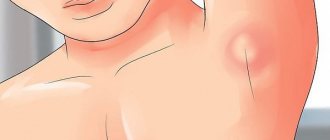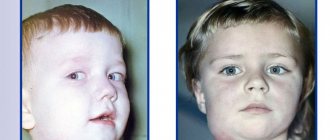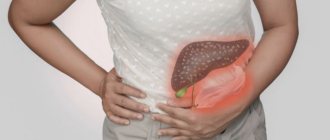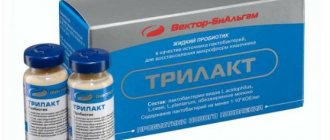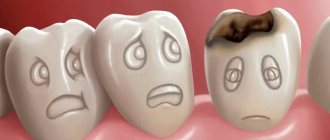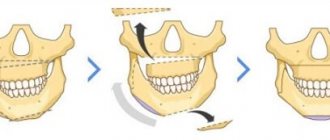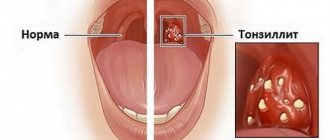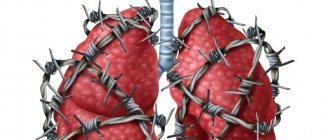In the jaw lymph nodes, the lymph circulating in the cells and capillaries of the oral cavity and head area is processed. Submandibular lymphadenitis is a polyetiological disease: its development can be caused by both chronic diseases and infections in the acute stage. The disease requires mandatory treatment from a specialist; it is impossible to cure lymphadenitis on your own
.
What is submandibular lymphadenitis, stages of development
Submandibular lymphadenitis is inflammation of the cervical and submandibular lymph nodes
, which can be acute or chronic. Often the disease is secondary, that is, it does not occur independently, but as a symptom of a primary infection.
Acute stage
In the acute form of the disease, one lymph node or several may become inflamed. Depending on what kind of exudate is contained in the inflamed node - pus or serous fluid - lymphadenitis is divided into purulent and non-purulent. The acute form of the disease is treated by removing pus from the lymph node and eliminating the root cause of inflammation.
If there is pus inside the lymph node, there is a danger of it breaking through and infecting surrounding tissues.
Chronic stage
The transition of the disease to the chronic phase is a consequence of the lack of adequate treatment. The node no longer increases in size and hardens. The pain syndrome intensifies, and severe intoxication of the body occurs. The skin around the node becomes purple.
Compared to the acute phase of the disease, with chronic lymphadenitis there is a clearly noticeable increase in the area of inflamed tissue around the lymph node
. The danger of this form of pathology is that it may require removal of the lymph node.
Causes of submandibular lymphadenitis
Inflammation of the cervical and jaw lymph nodes is associated primarily with diseases of the oral cavity and respiratory system.
The main causes of submandibular lymphadenitis are:
- An acute respiratory infection of viral or bacterial origin without a characteristic localization.
- Dental diseases. Especially often, the cause of the inflammatory process in the submandibular lymph nodes is advanced caries or one of its complications: pulpitis, periodontitis, gingivitis, periodontitis, periodontal disease.
- A history of throat diseases: tonsillitis, chronic sore throat, pharyngitis, adenoiditis.
- Acute otitis.
- Chronic or acute inflammation of the nasal sinuses: frontal sinusitis, sinusitis, sinusitis.
- Mechanical damage to the submandibular lymph node caused by trauma.
- The presence in the body of foci of chronic inflammation, characteristic of rheumatoid arthritis, STDs, HIV.
- Infection of the body with Koch's bacillus. The presence of a microorganism does not necessarily entail the development of a tuberculosis process, so the patient may not be aware of the infection. But even in a depressed state, Koch's wand can affect the lymph nodes.
Etiology of inflammation
According to Dr. Komarovsky’s long-term practice, enlarged lymph nodes in a child’s neck can occur for many reasons. The most common of them include infectious pathologies occurring in the body, a decrease in the immune protective function and related diseases, and the development of a tumor-like neoplasm.
Development of infectious diseases
If a lymph node in a child’s neck is inflamed, the doctor will first rule out diseases of the oral cavity and upper respiratory tract. Lymph nodes in this area become inflamed most often when nearby organs become infected, namely, with the development of the following diseases:
- Sore throat, which occurs with the formation of purulent cavities, which provokes an enlargement of the lymph nodes in the neck (article on this topic: Lymphadenitis in sore throat: causes, symptoms and methods of treatment)
- Infectious mononucleosis, which occurs with changes in nodes in different areas, not only in the neck. So, the lymph node behind the ear, lymph nodes in the groin and on the back of the head may enlarge.
- An acute respiratory disease, in which the enlarged lymph node does not hurt or cause other inconvenience. This happens especially often if the child is lymphatic (prone to frequent colds and other diseases of similar etiology).
- A purulent process occurring in the oral cavity, for example, if an infection gets into a tooth cavity or wound.
- Tuberculosis is an infectious disease in which the lymph nodes are enlarged not only in the child’s neck and behind the ear, but also in other areas of the body, for example, in the thoracic region.
Symptoms, photos and diagnosis of submandibular lymphadenitis
Submandibular lymphadenitis can be distinguished from the usual enlarged lymph nodes, which occurs with reduced immunity, by the presence of pain and compaction. If there is no pain when you touch the node and the lump is not palpable, its enlargement may be caused by decreased immunity. A compacted lymph node can signal the development of oncology, so if it is detected, it is necessary to urgently be examined by a doctor.
Submandibular lymphadenitis is characterized by enlarged lymph nodes, but it is not the main symptom. For a doctor to suspect lymphadenitis, at least one of the following signs must appear:
- Pain syndrome. In the early stages of the development of the disease, aching, nagging pain of high intensity is noted in the lower part of the head - under the lower jaw. Severe pain is felt when lightly pressing on the lymph node, during chewing, when yawning, or turning the head. As the disease progresses, pain during palpation increases, and then at rest. Patients are unable to relieve pain on their own.
- Significant enlargement of the lymph node and severe swelling, which makes swallowing difficult and provokes a feeling of fullness in the sublingual area. When swallowing, there is a feeling that a piece of food is too large. Speech becomes difficult.
- Labored breathing. It occurs gradually and is accompanied by cyanosis of the nasolabial triangle and pallor of the skin of the face.
- Visually noticeable swelling under the cheek. The size of the compaction depends on the severity of the ongoing pathological process, the amount of serous fluid and pus.
- An increase in body temperature to 39–40 °C, which may be accompanied by severe headache and sweating. This temperature is difficult to reduce with conventional antipyretics.
- Redness of the skin above and around the node. If pus has accumulated in the node, the skin around it will acquire a pronounced purple tint.
An accumulation of pus can be detected by palpation; pus can be felt even through the texture of the skin and node.
If there are signs of inflammation of the submandibular lymph node, you should seek help from a doctor. The treatment of lymphadenitis is carried out by therapists, otolaryngologists and surgeons.
Photo: chronic inflammation of the lymph node
Photo: acute inflammation of the lymph node
In addition to visual inspection and palpation of the node, doctors use several other clinical diagnostic methods:
- General blood analysis. With the development of submandibular lymphadenitis, there is a significant increase in the level of leukocytes in the blood.
- Ultrasonography. Allows you to detect the presence of pus and serous fluid inside the lymph node.
- Bacteriological analysis of fluid from a lymph node. Allows you to determine the type of bacteria that caused the inflammation and select the most effective antibiotics.
- Carrying out a complete differential (excluding other diseases) diagnosis. It is necessary due to the similarity of the symptoms of submandibular lymphadenitis with other diseases: inflammation of the salivary glands, adenoiditis.
To prescribe the correct treatment, it is necessary to identify the form of the disease and determine the severity of the pathological process.
Symptoms of inflammation
Enlarged lymph nodes in a child’s neck are not difficult to detect. They rise above the skin level, which is noticeable to the naked eye and without additional research.
The specific location of the inflammatory process may differ in one child or another. So, in some there is an increase in the anterior cervical nodes, while in others - in the rear. Sometimes, depending on the cause of the symptom, the affected nodes may hurt, especially when palpating or trying to turn the head. The general or local temperature may also increase, febrile syndrome and other intoxication manifestations may occur.
In normal condition, the lymph nodes located on the child’s neck are easily palpable. Their size does not exceed 1 centimeter. No pain syndrome occurs. Symptoms such as causeless enlargement of nodes up to 2 centimeters or more, pain, and their displacement in relation to the skin should alert you.
Not only the size of the lymph node is taken into account, but also its consistency. So, if an enlarged lymph node is associated with an inflammatory process occurring here, it will be soft and elastic to the touch. An increased density is observed in the presence of metastases in this area, spread from the primary focus. A pathological connection of the lymph node with the surrounding tissue occurs in the presence of a malignant tumor.
How to treat submandibular lymphadenitis
Inflammation of the submandibular lymph nodes can be completely cured only with an integrated approach
. The doctor determines the treatment regimen for submandibular lymphadenitis in a child or adult after studying all the symptoms and medical history of the patient.
The first stage of treatment is carried out by dentists and surgeons and may include medical and surgical therapies. At this stage, two main tasks must be solved - sanitation of the source of infection and relief of pain. The main groups of prescribed drugs are:
- Antibiotics. In the vast majority of cases, the disease is bacterial in nature, so treatment of submandibular lymphadenitis requires antibiotics
. Penicillin antibiotics are usually used, since the typical causative agents of the disease are streptococci or staphylococci. To select the most effective drug, the doctor may prescribe the patient to take a puncture to determine the resistance of bacteria to a particular drug. Ampicillin, Ampiox, Oxacillin, Bicillin, Amoxicillin or Ticarcillin are usually prescribed. - Anti-inflammatory drugs. Used to relieve inflammation. The medicine should be selected by the attending physician, taking into account the course of the disease and medical history.
- Analgesics. Necessary solely to eliminate acute pain syndrome. Analgesics are a concomitant medication; the main medicine for submandibular lymphadenitis in adults is antibiotics.
In parallel with drug therapy, the doctor sanitizes the foci of infection. If the cause of the disease is inflammation of the oral mucosa, then it will be treated by a dental surgeon.
To quickly relieve inflammation and speed up the recovery process in the purulent form of lymphadenitis, the node is surgically opened, after which the accumulated pus is removed from it.
When the original source of inflammation has been eliminated and the acute period of the disease has passed, the doctor will prescribe physiotherapy to the patient. Electrophoresis is especially effective. At this stage of treatment, you can use folk remedies for a speedy recovery.
Submandibular lymphadenitis in children
In children, submandibular lymphadenitis occurs less frequently than in adults. In children under three years of age, the disease cannot develop at all, which is due to the peculiarities of the formation of the lymphatic system.
Photo: submandibular lymphadenitis in a child
If a child is bothered by pain in the neck or jaw area, parents should carefully palpate the nodes. Healthy lymph nodes are quite soft and mobile, and the procedure itself is absolutely painless. If pain occurs or a lump is detected, you should immediately contact your pediatrician.
The main cause of inflammation of children's lymph nodes is diseases of the teeth, gums and infection in the nasopharynx. The doctor determines the treatment regimen for submandibular lymphadenitis in a child individually, taking into account the patient’s age and the admissibility of taking medications.
Prevention of submandibular lymphadenitis
Prevention of submandibular lymphadenitis involves taking measures to prevent the development of diseases that can cause an inflammatory process in the lymph nodes:
- During periods of acute respiratory infections epidemic, you should avoid crowded places and take all measures to prevent respiratory diseases.
- It is necessary to undergo a timely examination by a dentist and carry out all necessary treatment measures.
- It is necessary to properly and completely treat diseases of the nasopharynx, to prevent acute forms of ENT pathologies from becoming chronic.
Diagnosis and treatment according to Komarovsky
To determine the cause of inflammation of the lymph nodes in a child’s neck, the doctor first of all conducts a detailed examination of the affected area and palpation. Additional instrumental and laboratory tests are also prescribed.
A lymph node biopsy is necessary, which is prescribed if anti-inflammatory drugs are ineffective. Also, a diagnostic measure is carried out if there is a significant increase in the node, when its diameter exceeds 3 centimeters and if the development of a malignant neoplasm is suspected.
If a biopsy is necessary for a child under 1 year of age, general or local anesthesia is used, depending on the complexity of the diagnosis. If there is a need for surgery, the specialist takes a sample of biological material from the lymph node and sends it for laboratory testing. In this case, you can determine the type of tumor present and the most effective treatment.
According to Dr. Komarovsky, diagnosis of enlarged lymph nodes in the neck in children should be carried out only in a good virology laboratory. It is thanks to modern equipment and highly qualified specialists that the most accurate diagnostic results can be achieved.
If the viral etiology of the inflammatory process in the lymph nodes is confirmed, the doctor advises not to carry out any specific treatment. Their size will return to normal as soon as the body's defenses cope with the pathogenic microorganism. If the inflammation of the nodes is associated with a staphylococcal or streptococcal infection, antibacterial therapy is carried out.

